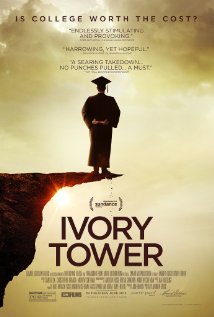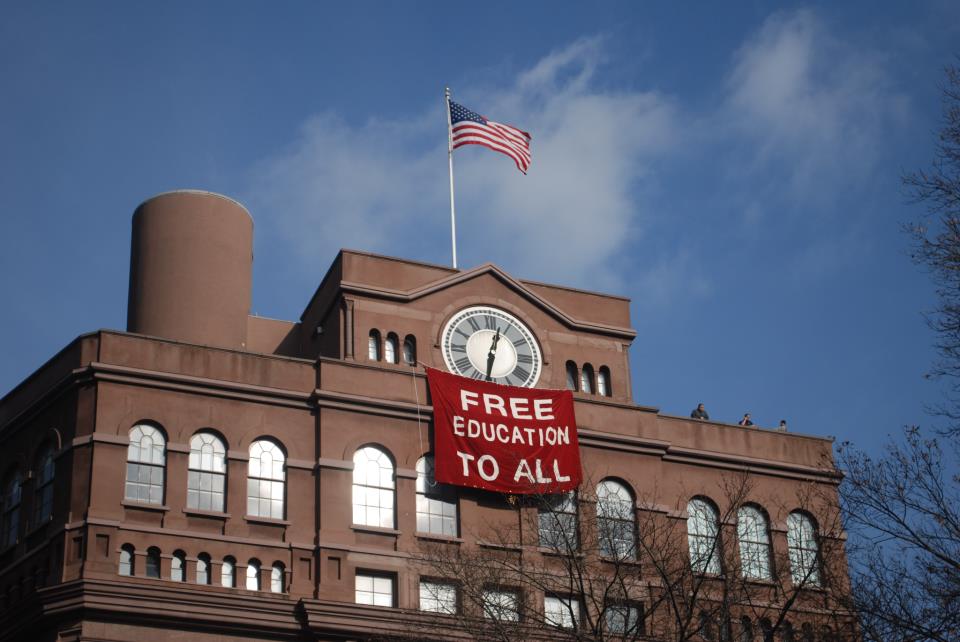 I finally caught up with the CNN-supported documentary Ivory Tower (2014). In it Andrew Rossi offers an overview of the current status of American higher education. I’d like to share some thoughts here.
I finally caught up with the CNN-supported documentary Ivory Tower (2014). In it Andrew Rossi offers an overview of the current status of American higher education. I’d like to share some thoughts here.
We need to realize this moment in the country, with a trillion dollars in student debt, with all the models of higher education as a business, it’s failing.
-Cooper Union student
The movie begins with American studies professor Andrew Delbanco walking to his campus, Columbia University. He gets the movie’s first lines, and uses them to talk about sadness and melancholy, of all things, neatly establishing tone and a theme (see below).
After following him through campus, the movie briskly moves on to Peter Thiel, Anya Kamenetz, Clayton Christensen, and Anthony Carnevale. And then many more.* This is primarily a movie based on people talking to us. Director Rossi doesn’t appear directly.
Those speaking people cover an awful lot of ground in just over one hour. They provide a sketch of American higher education history, from John Harvard to the Morrill Act to federal student aid and Pell Grants. They present data and topics, which include debt, rising tuition, the decline in state support, and the amenities arms race (climbing walls, pools, plasma tvs, student centers, football stadiums mentioned). Also covered are institutional debt, students as consumers, administrative growth and costs, the decline of academic rigor, student delaying or failing to graduate, the decline of tenure, and the rise of adjuncts.
Ivory Tower goes on to hit the shift from seeing higher education as a public good to a private good. We see intergenerational tensions (Boomers criticizing Millenials), dropping out versus the college premium, the rise of the MOOCs bubble and its popping, class differences in education, and even the flipped classroom and blended learning.
How are these titular ivory towers responding to such threats? Institutions are… not doing much, in this movie. Public universities are increasing out-of-state enrollment, as that brings in more tuition revenue per student. Just about everyone’s increasing tuition, or charging it for the first time, as in the Cooper Union case. Most campuses are trading tenured faculty for adjuncts. One lone campus in the movie tries something new, integrateing MOOCs in a programmatic way, but it backs off when that doesn’t work out. Ivory Tower is a portrait of institutional stasis.
We see some of those institutions in greater detail, starting with Columbia’s campus. Harvard gets the star treatment, with loving glimpses of the inevitable John Harvard statue, impressive buildings, and energetic students. Then, for contrast ,we head to Arizona State, giving the movie an opportunity to show off student decadence (this receives some minutes) and to mention the decline of academic rigor, a la Academically Adrift. The ASU tour also offers a welcome emphasis on the public university, with its president insisting that the institution charge the “lowest possible cost”.
Ivory Tower also visits Deep Springs College, then Spelman College, offering some much-needed institutional and racial diversity. The movie next turns to Cooper Union, where it settles in for a good while, in order to address that school’s unusual tuition history and the recent controversy over its board’s decision to charge for it. These scenes include good footage of the student occupation.
Also in New York, Ivory Tower shows us NYU. Then the movie crosses the US, heading to Stanford, San Jose State University, and Bunker Hill Community College, the last two offering more diversity, this time on the economic from. The movie also touches on the San Francisco Hackerhouse as a kind of alternative learning space.
Ultimately Ivory Tower ends this tour of campuses and people with a frustration verging on depression. During the last few minutes, after we listen to Andrew Delbanco sharing his admiration of students, we learn the Cooper Union occupation ended unsuccessfully and that its trustees once again charged tuition.
We see one former occupier being hopeful about impossible goals, and defeating tuition increases is clearly one. The movie signaled this frustrated theme from the start, with Delbanco’s opening lines about melancholy. The film’s title actually appears over a nighttime image of campus windows glowing red (!) against a dark background. That the red was a Cooper occupation symbol makes it both ominous and elegiac.
MOOCs have failed to improve things in the movie. State governments aren’t going to help, according to the experts. And every single one the crisis elements are still in play. The End.
I actually admire much in this movie, including its ambitious sweep, the selection of experts, the use of Cooper Union as an anchor story, and its attention to students. But flaws and problems kept cropping up in my notes:
- It emphasizes traditional-age residential schools. It has nothing on adult learners, the majority of higher education students now, and far too much of Harvard. The heart of the movie is really about what one expert refers to as “elite residential higher education” (Stevens). I wish the film had been more upfront on this score.
- The Thiel Fellowship receives uncritical treatment, unusual for a movie which often presents multiple perspectives. There’s even an odd title card with this claim: “San Francisco is home to a growing ‘UnCollege’ movement supported by the Thiel Fellowship” (57:35). There’s a movement?
- MOOCs are all xMOOCs. There’s no mention of cMOOCs. Sebastian Thrun is the founder of MOOCs in the movie. No Connectivism, no DS106.
- The Cooper Union story uses the word “occupation” and shows the human mic technique several times, but never mentions the Occupy movement.
- The movie overstates student debt holdings. At one point a voiceover claims average student debt is more than $20,000. Later we see students with more than $100,000 in debt. But we don’t see the roughly 1/3rd of students who have no debt, nor the students with less than the actual average of roughly $30,000.
- For a movie interested in changing higher education, Ivory Tower doesn’t describe any ways of altering what’s being done other than MOOCs. The movie mentions administrative staff growth, but doesn’t note any attempts to redress the problem. The rising proportion of adjuncts appears early on, and we finally get one adjunct on camera, but there’s nothing about unionization. The amenities arms race is mentioned, and lavish athletics programs pictured, but never challenged. The Academically Adrift claim about declining academic rigor appears early, and never returned to nor addressed. The movie seems to want states to spend more on public schools, but never makes a real case for this, nor explains how that would help. (Such a spending change, while welcome, wouldn’t touch private institutions, nor fully address spiraling costs, which far exceeded state support reductions.)
- Missing from the film’s points is the increasing number of Americans who went to college over the past 50 years, and the cultural sense that nearly everyone should go.
- Critics have noted the film seems crammed, muddled or scattershot, and there’s much to that.
It’s interesting that information professionals don’t appear in the movie. We don’t see or hear from any librarians, IT people, or CIOs. All of the experts are professors, non-information-related academic executives, journalists, or non-faculty researchers. This is both a blind spot for Ivory Tower and a datapoint that should concern information pros.
All in all, this is an ambitious movie. The huge amount of topics it covers should be instructive to many audiences. Its gaps and blind spots concern me: politics, historical context, information technology. The historical awareness is interesting, as though higher ed history stopped around 1980. It feels like a mainstream account, almost a conservative one. The attention to present data counterbalances a nearly nostalgic sense of college for 18-year-olds.
Ivory Tower‘s lack of a positive conclusion should worry everyone in education.
(Cooper Union photo from Wikipedia)
*How many more people? Mitchell Stevens (Stanford), Jeff Selingo (Chronicle of Higher Ed), Teresa Sullivan (University of Virginia), Richard Arum (NYU), Michael Roth (Wesleyan), Michael Crow (Arizona State). Laura Hamilton and Elizabeth Armstrong, co-authors of Paying for the Party (2013; my review notes), outlining the party pathway problem. Richard Arum, co-author with Josipa Roksa of Academically Adrift (2011). Peter Buckley and Jamshed Bharucha (Cooper Union), Louis Menand (Harvard), Elizbeth Warren (US Senate), Peter Schiff (finance). Dale Stephens (UnCollege), Michael Staton (Learn Capital). Mark Zuckerberg (Facebook), Michael Bloomberg (NYC). John Hennessy, Daphne Koller, and Sebastian Thrun (Stanford). John Owens (UC Davis). Jerry Brown (California). Rita Manning, Ann Larson, and Peter Hadreas (San Jose State University). Jaime L’Heureux (Bunker Hill Community College). Many students, both interviewed and en masse. Several parents.






Pingback: One more American college to close | Bryan Alexander